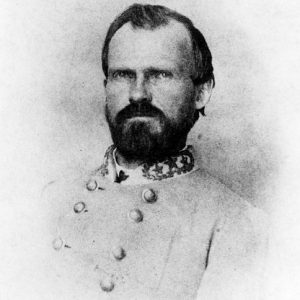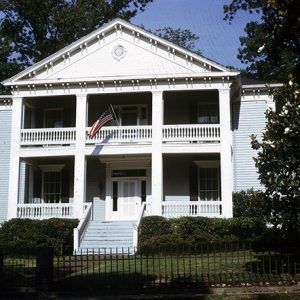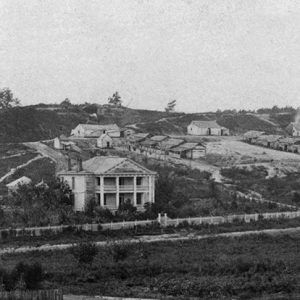calsfoundation@cals.org
James Camp Tappan (1825–1906)
James Camp Tappan was a Confederate general, lawyer, and politician from Helena (Phillips County). He is best remembered for commanding a brigade of Brigadier General Thomas J. Churchill’s Arkansas Division.
James Tappan was born on September 9, 1825, in Franklin, Tennessee, the son of Benjamin S. Tappan and Margaret Bell Camp Tappan. He was the oldest of thirteen children. He received his education at Exeter Academy in New Hampshire and Yale University in Connecticut, graduating in 1845. He then studied law in Vicksburg, Mississippi, and joined the bar of that state in 1846. In 1848, Tappan moved to Helena and began practicing law there and married his wife, Mary, in 1854. Tappan served a term in the Arkansas legislature as a member of the House from 1850 to 1851. He also served as a circuit court judge before the Civil War.
At the outbreak of the war, Tappan joined the Confederate army and was commissioned colonel of the Thirteenth Arkansas Infantry Regiment in May 1861. The Thirteenth Arkansas first saw action under Tappan at the Battle of Belmont, Missouri, under the command of General Leonidas Polk, who commended Tappan on his military skills during the engagement. The Thirteenth Arkansas soon moved east of the Mississippi River and fought at Shiloh, Tennessee, in April 1862, where Tappan returned from an illness furlough to help lead his regiment.
In the autumn of 1862, Tappan and the Thirteenth Arkansas took part in the invasion of Kentucky, where they fought at Richmond and Perryville before being turned back. Tappan was promoted to the rank of brigadier general on November 5, 1862. He was then transferred back to the Trans-Mississippi Department.
In Arkansas, Tappan commanded a brigade made up of the Thirty-third Arkansas, Twenty-Seventh and Thirty-Eighth Arkansas Consolidated, and Dawson’s Nineteenth and Twenty-Fourth Arkansas. The brigade was placed in Brigadier General Thomas J. Churchill’s Arkansas Division, which, along with Brigadier General Mosby M. Parsons’s Missouri Division, was under the command of Major General Sterling Price.
Churchill’s division was stationed in southern Arkansas after the capture of Little Rock (Pulaski County) in September 1863. In March 1864, the division, along with other Confederate infantry units in the area, moved to northwestern Louisiana in response to Major General Nathaniel Banks’s thrust up the Red River. Tappan was given temporary command of the entire Arkansas Division as Churchill temporarily took Price’s position.
The Arkansas troops were held in reserve at the Battle of Mansfield or Sabine Crossroads on April 8, 1864. At this battle, Banks’s army was defeated and began to retreat back down the Red River. The next day, the Arkansas Division hit Banks at Pleasant Hill, Louisiana. The Union army was able to repel the Confederate attack and continue its retreat down the Red River.
The Arkansas Division then moved back into Arkansas to attack Major General Frederick Steele’s army. Steele was cooperating with Banks in an attempt to capture Shreveport but was forced to take shelter in Camden (Ouachita County). Steele began retreating to Little Rock, his starting point. The Confederate infantry caught up with the Union army near Jenkins’ Ferry on the Saline River in present-day Grant County. At the Engagement at Jenkins’ Ferry, Tappan’s brigade suffered 144 casualties, and the Arkansas Division as a whole suffered 243 casualties. Tappan’s brigade was the first Arkansas infantry unit to engage the Union forces at Jenkins’ Ferry and did so completely alone. Generals Price and Churchill ordered the units to be deployed one at a time into the battle and thus Tappan’s brigade suffered higher casualties than the rest of the division.
Tappan’s brigade remained stationed in southern Arkansas for the remainder of the war. At the end of hostilities, Tappan returned home to Helena and resumed his law practice. His daughter, Mary, was born in 1871. He established a law firm, Tappan and Horner, with Major J. J. Horner and was reelected to the state House of Representatives in 1897, serving until 1900, including a stint as speaker of the house from 1897 to 1898. He died on March 19, 1906, and is buried in Maple Hill Cemetery in Helena.
For additional information:
Justice, Ernest D. “James Camp Tappan: His Life and Deeds.” Phillips County Historical Quarterly 3 (June 1965): 5–18.
Morrow, Jno. P., Jr. “Confederate Generals from Arkansas.” Arkansas Historical Quarterly 21 (Autumn 1962): 231–246.
Warner, Ezra J. Generals in Gray: Lives of the Confederate Commanders. Baton Rouge: Louisiana State University Press, 1959.
David Sesser
Nevada County Depot and Museum
 James Tappan
James Tappan  James C. Tappan House
James C. Tappan House  James C. Tappan House
James C. Tappan House 



Colonel Tappan was not present for almost all of the Battle of Shiloh, arriving on the battlefield late the second day on his return from sick furlough. Major McNeely led the regiment through most of the fighting on both days after the death of LTC Grayson.